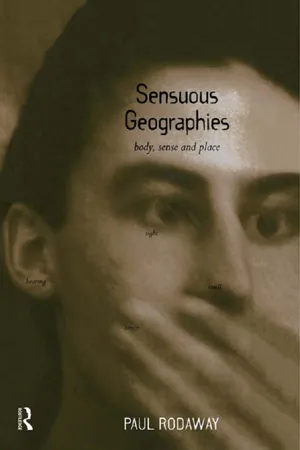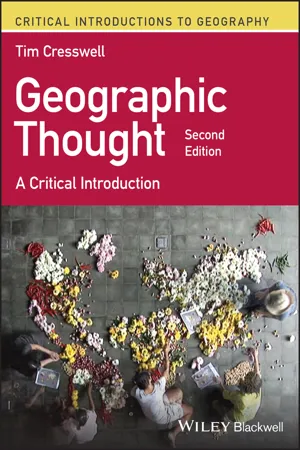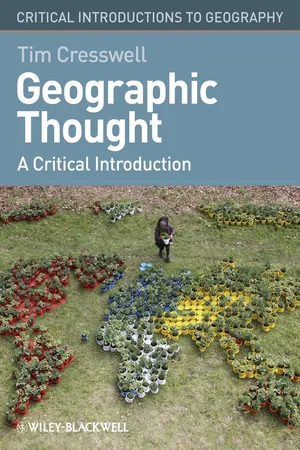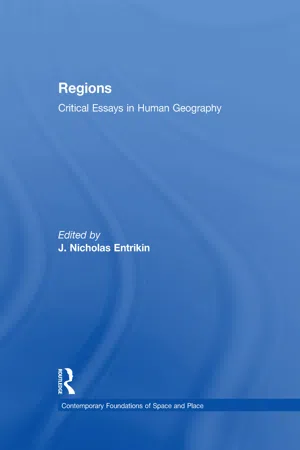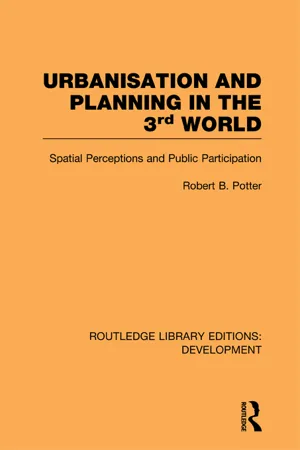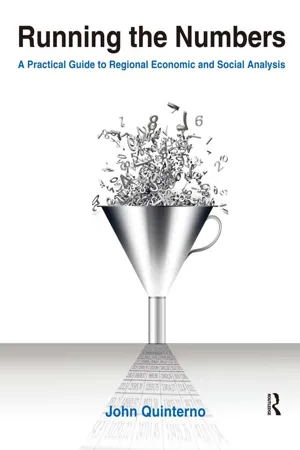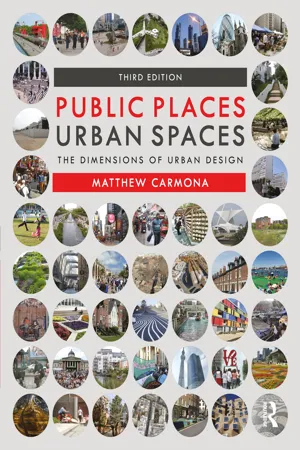Geography
Perceptual Region
A perceptual region refers to an area defined by people's beliefs, feelings, and attitudes rather than by objective data. It is based on individuals' perceptions and can vary from person to person. Perceptual regions are important in geography as they help understand how people mentally organize and interpret the world around them.
Written by Perlego with AI-assistance
Related key terms
Related key terms
1 of 4
Related key terms
1 of 3
7 Key excerpts on "Perceptual Region"
- eBook - ePub
Sensuous Geographies
Body, Sense and Place
- Paul Rodaway(Author)
- 2002(Publication Date)
- Routledge(Publisher)
(‘-graphe’). It is a representation of an experienced world, both perceived directly through the senses and mediated by the mind. Perception as a process by which data is collected and ordered is therefore fundamental to geographical enquiry. Geographical perception is simply the perception of a world around us, of spatial relationships and the identification of distinctive places—to recognise our situation in a world and to have a sense of a world. Sensuous geography—as a focus on the role of the senses—might be located in the sub-field of perception studies.In general, geographers have been somewhat uncritical in their use of the term ‘perception’ and have drawn heavily upon a limited range of psychological theories whilst not generally taking account of the critical traditions underlying these theories. A move from a psychological and biological interest in perception processes to a geographical one is far more fundamental than was originally realised. Geographical interest is in perception in complex everyday environments and decision-making in widely differing socio-economic and cultural contexts. These wider issues of perception call for a distinctive geographical formulation of perception models.There have been numerous reviews and collections of ‘perception geography’ (e.g. Wood 1970 ; Gold 1980 ;Saarinen et al. 1984; Aitken 1991 ). Some reference has been made to ethnocentric and eurocentric views of the world (e.g. Tuan 1974 ), but in general this dimension has been given little attention. The behavioural or perceived environment (Kirk 1963 ) has been, with hindsight, perhaps the most influential concept to develop out of the interest of geographers in perception. This suggests that individuals and groups do not make decisions based on full, accurate and objective knowledge of their environment, but a more partial, less accurate and subjective view of their environment derived from the mediation of previous experience, education and social conditioning, and expectations and hopes. Behavioural decisions are made on the basis on this environment as perceived (Brookfield 1969 - eBook - ePub
Geographic Thought
A Critical Introduction
- Tim Cresswell(Author)
- 2024(Publication Date)
- Wiley-Blackwell(Publisher)
Chapter 4 Thinking About Regions- Approaching the Region
- Critiquing the Region
- New Regional Geographies
- Critical Regionalism
- Conclusion
The regional concept constitutes the core of geography. This concept holds that the face of the earth can be marked off into areas of distinctive character; and that the complex patterns and associations of phenomena in particular places possess a legible meaning as an ensemble which, added to the meanings derived from a study of all the parts and processes separately, provides additional perspective and additional depth of understanding. This focus of attention on particular places for the purpose of seeking a more complete understanding of the face of the earth has been the continuous, unbroken theme of geographic study through the ages.(James 1929 : 195)Two questions have motivated geographical thinking over the past 2,000 years more than any others. These are “what is the connection between the human and physical worlds?” and “how can we account for spatial difference?” The second of these questions lay at the heart of what Varenius called “special geography” with its focus on particular areas of the earth's surface and the qualities that make these areas different and unique from the areas around them. It is this line of enquiry that lies at the heart of human geography over the first half of the twentieth century. The concept that exemplifies this pursuit is region. At first glance the idea of a region seems a fairly vague one. It might, for instance, be thought of as a synonym for “area.” One question that immediately arises is at what scale a region exists. As a word that is used in everyday speech, it most often suggests a subdivision of something bigger. Regional art, for instance, signifies artistic practices, styles, and products that are associated with a particular bit of a nation – say the Midwest of the United States. But we would be unlikely to label a national art form regional even if a nation is part of a larger continental or global whole. We can even think of a house as having particular regions if we happen to be a sociologist trained in the work of Erving Goffman who might describe the living room, drawing room, or lounge of a house as the “front region” while the kitchen or bedrooms are part of the “back region” – not for public consumption (Goffman 1956 - eBook - ePub
Geographic Thought
A Critical Introduction
- Tim Cresswell(Author)
- 2012(Publication Date)
- Wiley-Blackwell(Publisher)
Chapter 4 Thinking About Regions The regional concept constitutes the core of geography. This concept holds that the face of the earth can be marked off into areas of distinctive character; and that the complex patterns and associations of phenomena in particular places possess a legible meaning as an ensemble which, added to the meanings derived from a study of all the parts and processes separately, provides additional perspective and additional depth of understanding. This focus of attention on particular places for the purpose of seeking a more complete understanding of the face of the earth has been the continuous, unbroken theme of geographic study through the ages. (James 1929: 195) Two questions have motivated geographical thinking over the past 2,000 years more than any other. These are “what is the connection between the human and physical worlds?” and “how can we account for spatial difference?” The second of these questions lay at the heart of what Varenius called “special geography” with its focus on particular areas of the earth’s surface and the qualities that make these areas different and unique from the areas around them. It is this line of enquiry that lies at the heart of human geography over the first half of the twentieth century. The concept that exemplifies this pursuit is “region.” At first glance the idea of a region seems a fairly vague one. It might, for instance, be thought of as a synonym for “area.” One question that immediately arises is at what scale a region exists. As a word that is used in everyday speech it most often suggests a subdivision of something bigger. Regional art, for instance, signifies artistic practices, styles, and products that are associated with a particular bit of a nation – say the Midwest of the United States. But we would be unlikely to label a national art form regional even if a nation is part of a larger continental or global whole - eBook - ePub
Regions
Critical Essays in Human Geography
- J. Nicholas Entrikin(Author)
- 2017(Publication Date)
- Routledge(Publisher)
“Any segment or portion of the earth surface is a region if it is homogeneous in terms of such an areal grouping. Its homogeneity is determined by criteria formulated for the purpose of sorting from the whole range of earth phenomena the items required to express or illuminate a particular grouping, areally cohesive. So defined, region is not an object, either self-determined or nature-given. It is an intellectual concept, an entity for the purpose of thought, created by the selection of certain features that are relevant to an areal interest or problem and by the disregard of all features that are considered to be irrelevant”.The definitions presented above (1) are geography-centred and (2) begin from the concept of region itself. The latter fact contains implicitly the idea of a geographical region as a kind of entity (although not necessarily’ an object), which geographers have to discover or produce as a result of the research process. Hence the ultimate nature of geographical regions will be defined on the basis of research problems, whatever they may be. The region is essentially a mental category to be employed in classifying or organizing geographical data (see Hartshorne 1939, Kostbade 1968, cf. Entrikin 1981b). The most difficult problem for the conceptualizations like this is that they basically reduce the region to a static, stable entity, rather than a developing, transforming and continually reproduced expression of time-space specific relations and structures in society. Classical descriptions and interpretations of homogeneous (or uniform) regions have of course been, and still are, important and necessary for human beings and for their practical purposes. They are means of making the world clearer and more graphic. Methodologically, however, the problem is that definitions like those above emerge ontologically from the reality of the discipline, not from that of the society , which means that space is separated from social processes.In this respect the concept of functional region , the evolution of which is closely connected with the development of geographical thought in the spatial tradition, is more explicitly related to the spatial structure of human practices and thus advances further from the pure abstraction of region. In practice functional regions are classifications of the facts and processes of society and hence are significant in administration and planning within the society. This being the case, geographers have established a relation with the public sphere of society as power holders and may sometimes have played a substantial role in legitimizing the formation and emergence of new regions. In other words, the results of functional classifications will have been used as technical instruments to analyse the socio-spatial processes in society. Especially for geographers who regard their subject as a spatial science, region has become important as a technical category to be employed in various classifications, i.e. in regionalization. - eBook - ePub
Urbanisation and Planning in the Third World
Spatial Perceptions and Public Participation
- Robert Potter(Author)
- 2012(Publication Date)
- Routledge(Publisher)
Perception is a word that is used to describe the process by means of which individuals become aware of and interpret their surroundings via the medium of the senses, and also the product of that process (Skurnik and George, 1964; Goodey, 1973). Strictly defined, perception relates to the act of interpreting and coding the sensory stimulation that is experienced at the present time. But all individuals have received previous stimuli which influence and colour the here and now of everyday experience. This totality of knowing is referred to as ‘cognition’. Such a summation of an individual's past, present and perhaps even future anticipated stimuli is obviously not dependent on direct first-hand personal experience alone and will be greatly influenced by the mass media and interpersonal communication (see, for example, Walmsley, 1982; Gould and Lyew-Ayee, 1983). It is precisely because past perceptions influence peoples’ immediate cognitions that spatial stereotypes and perceptual inertia frequently occur. Hence, in common parlance, many individuals “know what they like and like what they know”. Thus, when considering spatial cognitions, it is tempting to invert the old adage that “seeing is believing” and to suggest rather that “believing is seeing” (Pocock, 1981). Once established, regional images are likely to be remarkably resistant to change and often become a part of general parlance, even becoming enshrined in fictional literature (Pocock, 1979). Some researchers have gone so far as to refer to “myth maps” of countries due to the frequent occurrence of such distortions in the public's regional consciousness (Gould, 1969b; Jones, 1978), a theme which is investigated later in this chapter. Myth maps may be the result of chance, unfortuitous misinformation or even deliberate dissemination by those who stand to gain by their promotion and maintenance. Thus, it would be naive to assume that spatial images are not coloured by political expediency and/or commercial interest, as witnessed by regional policy and tourist resort advertising respectively.A highly simplified model of environmental perception and cognition is presented as a framework for discussion in Figure 6.1 . At a basic level, choice and subsequent overt spatial behaviour are mediated within the environment via the processes and products of environmental perception and cognition. As already stressed, this general notion applies whether we are talking of individuals, corporate groups, institutions, firms or indeed governments. It must be remembered, however, that choice is never absolute, for constraints serve to limit the possibilities that are open to different decision-makers at the same time, or the same ones at different times. Foremost amongst these are political and legal restrictions, financial and general economic conditions and the activities of urban managers such as planners and architects (see, for instance, Pahl, 1970; Gray, 1975; Hamnett, 1977; Williams, 1978). The intangible product of environmental perception-cognitions is referred to in a number of different ways. Among the most commonly employed descriptors are “cognitive” or “mental maps”, “images” and “schemata”, as indicated in Figure 6.1 - eBook - ePub
Running the Numbers: A Practical Guide to Regional Economic and Social Analysis: 2014
A Practical Guide to Regional Economic and Social Analysis
- John Quinterno(Author)
- 2014(Publication Date)
- Routledge(Publisher)
4Few residents of the Research Triangle would deny that it is a region of some sort, but many would contest its boundaries and its degree of interconnectedness. The Research Triangle nevertheless is a region in that it is “an area within the national economy that is sufficiently comprehensive in structure that it can function independently, although of course in most practical circumstances it has strong links with the rest of the economy.”5 Yet even that definition is vague, and in response, observers tend to view regions from one of three perspectives: territorial, functional, or administrative.Before describing each perspective, it is important to acknowledge that each one is more complex than its description implies. An exhaustive account is beyond this book’s scope, and the intention here is to provide a basic orientation to common ways of understanding regions. In practice, most regional studies blend the functional and administrative perspectives for reasons of feasibility and because civic leaders tend to think in terms of administrative structures. The exact mix of perspectives, however, hinges on the particular research questions and the availability of pertinent data.TERRITORIAL PERSPECTIVEThe territorial perspective envisions a region as a “historically evolved, contiguous society that possesses a physical environment, a socioeconomic, political, and cultural milieu, and a spatial structure distinct from the other major territorial units, city, and nation.”6 The strength of this view is its recognition of the interplay between the physical environment and social dynamics. Regions are not simply discrete physical spaces, but rather the intricate products of economic and social interactions. Economic factors are particularly important in differentiating regions, as evidenced in the journalist Tom Wolfe’s observation about how when traveling by road in the United States “the only way you could tell you were leaving one community and entering another was when the franchises started repeating, and you spotted another 7-Eleven, another Wendy’s, another Costco, another Home Depot.”7 - eBook - ePub
Public Places Urban Spaces
The Dimensions of Urban Design
- Matthew Carmona(Author)
- 2021(Publication Date)
- Routledge(Publisher)
While sensations may be similar for everyone, individuals filter, react to, organise and value those sensations differently. These differences in environmental perception can be attributed to a number of factors: age, gender, ethnicity, lifestyle, length of residence in an area, usual mode of travel, and so forth; but also to the physical, social and cultural environment in which we live and were raised. Despite everyone effectively living in their ‘own world’, because of similarities in socialisation, past experience and the present urban environment, certain aspects of how we perceive will be held in common by large groups of people (Knox & Pinch, 2000: 295). Capturing these images of places or environments, ‘mental maps' or cognitive geography have become a central part of studies of environmental perception and are widely used in urban design. In essence they capture the subjective qualities of a place that individuals hold in their heads in a spatial form, by asking them to draw them (4.2). 4.2 Mental map, Piccadilly Circus to Regents Park and surrounds, London. Other tools have been developed in an attempt to capture the constituent ‘feelings' that inspire our perceptions in the first place and which inform our ongoing sentiments about the places we inhabit. Rofè (2004, 2012), for example, has developed a simple technique to create ‘Feeling Maps' of neighbourhoods by asking people to simply walk about an area and, as they do so, to score their feelings on a map through a simple scale from very good to very bad (4.3). Many years of using the tool reveals that feelings are often very local, are determined more by the immediate surroundings of a place than by the social background of the assessor, and reveal not only qualities that are sensed (good or bad) but also preconceived notions about particular locations based on previous knowledge
Index pages curate the most relevant extracts from our library of academic textbooks. They’ve been created using an in-house natural language model (NLM), each adding context and meaning to key research topics.
Explore more topic indexes
Explore more topic indexes
1 of 6
Explore more topic indexes
1 of 4
